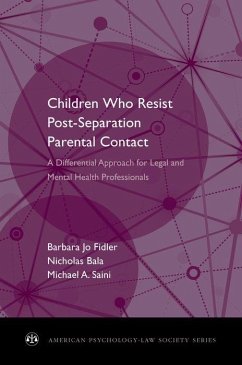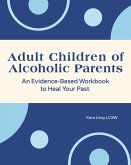Barbara Jo Fidler, Nicholas Bala, Michael A. Saini
Children Who Resist Postseparation Parental Contact
A Differential Approach for Legal and Mental Health Professionals
Barbara Jo Fidler, Nicholas Bala, Michael A. Saini
Children Who Resist Postseparation Parental Contact
A Differential Approach for Legal and Mental Health Professionals
- Broschiertes Buch
- Merkliste
- Auf die Merkliste
- Bewerten Bewerten
- Teilen
- Produkt teilen
- Produkterinnerung
- Produkterinnerung
Children Who Resist Post-Separation Parental Contact is a critical, empirically based review of parental alienation that integrates the best research evidence with clinical insight from interviews with leading scholars and practitioners.
Andere Kunden interessierten sich auch für
![Who Can I Trust? a Practical Guide Who Can I Trust? a Practical Guide]() Shaman Elder Maggie WahlsWho Can I Trust? a Practical Guide9,49 €
Shaman Elder Maggie WahlsWho Can I Trust? a Practical Guide9,49 €![In the Shadow of Death In the Shadow of Death]() Elizabeth BeckIn the Shadow of Death39,99 €
Elizabeth BeckIn the Shadow of Death39,99 €![2023 Weekly Planner with Password and Contact Pages 2023 Weekly Planner with Password and Contact Pages]() Journals and Notebooks2023 Weekly Planner with Password and Contact Pages14,99 €
Journals and Notebooks2023 Weekly Planner with Password and Contact Pages14,99 €![Adult Children of Alcoholic Parents Adult Children of Alcoholic Parents]() Kara LissyAdult Children of Alcoholic Parents40,99 €
Kara LissyAdult Children of Alcoholic Parents40,99 €![Stress Management for Adult Children of Alcoholics Stress Management for Adult Children of Alcoholics]() Lolita Scesnaviciute GuarinStress Management for Adult Children of Alcoholics28,99 €
Lolita Scesnaviciute GuarinStress Management for Adult Children of Alcoholics28,99 €![Alcoholics Anonymous - Big Book Special Edition - Including Alcoholics Anonymous - Big Book Special Edition - Including]() Alcoholics Anonymous World ServicesAlcoholics Anonymous - Big Book Special Edition - Including11,99 €
Alcoholics Anonymous World ServicesAlcoholics Anonymous - Big Book Special Edition - Including11,99 €![Twenty-Four Hours A Day Twenty-Four Hours A Day]() AnonymousTwenty-Four Hours A Day15,99 €
AnonymousTwenty-Four Hours A Day15,99 €-
-
-
Children Who Resist Post-Separation Parental Contact is a critical, empirically based review of parental alienation that integrates the best research evidence with clinical insight from interviews with leading scholars and practitioners.
Produktdetails
- Produktdetails
- Verlag: Oxford University Press
- Seitenzahl: 322
- Erscheinungstermin: 31. August 2012
- Englisch
- Abmessung: 234mm x 156mm x 17mm
- Gewicht: 491g
- ISBN-13: 9780199895496
- ISBN-10: 019989549X
- Artikelnr.: 35203087
- Herstellerkennzeichnung
- Libri GmbH
- Europaallee 1
- 36244 Bad Hersfeld
- gpsr@libri.de
- Verlag: Oxford University Press
- Seitenzahl: 322
- Erscheinungstermin: 31. August 2012
- Englisch
- Abmessung: 234mm x 156mm x 17mm
- Gewicht: 491g
- ISBN-13: 9780199895496
- ISBN-10: 019989549X
- Artikelnr.: 35203087
- Herstellerkennzeichnung
- Libri GmbH
- Europaallee 1
- 36244 Bad Hersfeld
- gpsr@libri.de
Barbara Jo Fidler is a registered psychologist and accredited mediator in Ontario. Nicholas Bala is a Professor of Law at Queen's University and a leading expert on issues related to children and families in the justice system. Michael A. Saini is an Assistant Professor in the Factor-Inwentash Faculty of Social Work at the University of Toronto.
* Contents
* About the Authors
* 1. Introduction
* 1.1 The Prevalence of Alienation
* 1.2 Prevalence of Alienation in Community Samples
* 1.3 Increase in the Number of Alienation Cases
* 1.4 Summary
* 2. Definitions and Debates
* 2.1 Historical Context
* 2.2 The Difficulty in Defining Alienation
* 2.3 Affinity and Alignment
* 2.4 The Role of the Adversarial System and Professional Advisors
* 2.5 Alienation Within the Context of High-Conflict Separations
* 2.6 Distinguishing Alienation from Justified Rejection
* 2.7 Mixed or Hybrid Cases
* 2.8 Dynamics in Alienation Cases
* 2.9 Alienation and False Allegations of Abuse
* 2.10 Debates about Parental Alienation as a Diagnosis or Condition
* 2.11 Summary
* 3. Risk Factors and Indicators Involved in Alienation
* 3.1 Extent and Limitations of Research on Alienation
* 3.2 Current Evidence on the Social and Psychological Factors
Associated with Alienation
* 3.3 Interparental Factors Following Separation or Divorce
* 3.4 Factors of the Favored Parent
* 3.5 Factors of the Rejected Parent
* 3.6 Factors of the Child
* 3.7 Summary of Factors and Indicators
* 4. Assessment and Measurement Tools for Alienation
* 4.1 Clinical Judgment
* 4.2 Decision Trees and Assessment Protocols
* 4.3 Measurement Scales
* 4.4 Differentiating Levels of and Responses to Strained Parent-Child
Relationships
* 5. Prognosis and Long Term Consequences of Untreated Alienation on
Young Adults and Their Families
* 5.1 The Impact of Alienation on Children and Adults who were
Alienated as Children
* 5.2 Spontaneous Reconciliation
* 5.3 When to Suspend Efforts or Letting Go
* 6. Prevention
* 6.1 Universal or Primary Prevention
* 6.2 Public Awareness
* 6.3 Selected or Secondary Prevention
* 6.4 Indicated or Tertiary Prevention
* 6.5 Summary
* 7. Interventions, Educational and Therapeutic
* 7.1 The Role of the Court in Educational and Therapeutic
Interventions
* 7.2 Principles and Guidelines
* 7.3 Goals of Counseling
* 7.4 Treatment Modalities, Approaches and Strategies
* 7.5 Summary of Specific Interventions, Protocols or Approaches
* 7.6 Aftercare, Training, Accessibility and Costs of Interventions
* 7.7 Concluding Comments
* 8. Hearing the Voices of Children in Alienation Cases
* 8.1 Children's Stated Wishes: Clinical Perspectives
* 8.2 Children's Right of Participation
* 8.3 Children's Stated Wishes: Weight in the Courts
* 8.4 Methods for Courts Hearing the Views and Wishes of Children
* 8.5 Concluding Comments: Principles, Policies and Research
* 9. Legal Responses to Alienation and Contact Problems
* 9.1 Child's 'Rights,' Parental Duties and the Best Interests of the
Child
* 9.2 The Role of Mental Health Experts in Resolving Alienation Cases
* 9.3 Enforcement issues and Judicial Remedies
* 9.4 Therapeutic Interventions and the Court Process
* 9.5 The Content of Agreements and Orders for Therapeutic Involvement
* 9.6 Adjusting Visitation and Interim Orders
* 9.7 Contempt of Court: Punitive Sanctions and Behavioral Conditions
* 9.8 Police Enforcement
* 9.9 Supervision of Contact
* 9.10 Award of Legal Fees
* 9.11 Joint Custody - Increasing Time in Care of Target Parent
* 9.12 Custody Reversal: an Option for Severe Cases
* 9.13 Suspension of Contact
* 9.14 Deciding Not to Enforce Contact Despite Alienation
* 9.15 Financial Penalties
* 9.16 Case Management - The Need for Judicial Control
* 9.17 Child Protection Agency Involvement
* 9.18 The Importance of Timely Legal Intervention
* 9.19 Conclusion: The Law as a Blunt but Necessary Instrument
* 10. Recommendations for Practice, Policy and Research
* References
* About the Authors
* 1. Introduction
* 1.1 The Prevalence of Alienation
* 1.2 Prevalence of Alienation in Community Samples
* 1.3 Increase in the Number of Alienation Cases
* 1.4 Summary
* 2. Definitions and Debates
* 2.1 Historical Context
* 2.2 The Difficulty in Defining Alienation
* 2.3 Affinity and Alignment
* 2.4 The Role of the Adversarial System and Professional Advisors
* 2.5 Alienation Within the Context of High-Conflict Separations
* 2.6 Distinguishing Alienation from Justified Rejection
* 2.7 Mixed or Hybrid Cases
* 2.8 Dynamics in Alienation Cases
* 2.9 Alienation and False Allegations of Abuse
* 2.10 Debates about Parental Alienation as a Diagnosis or Condition
* 2.11 Summary
* 3. Risk Factors and Indicators Involved in Alienation
* 3.1 Extent and Limitations of Research on Alienation
* 3.2 Current Evidence on the Social and Psychological Factors
Associated with Alienation
* 3.3 Interparental Factors Following Separation or Divorce
* 3.4 Factors of the Favored Parent
* 3.5 Factors of the Rejected Parent
* 3.6 Factors of the Child
* 3.7 Summary of Factors and Indicators
* 4. Assessment and Measurement Tools for Alienation
* 4.1 Clinical Judgment
* 4.2 Decision Trees and Assessment Protocols
* 4.3 Measurement Scales
* 4.4 Differentiating Levels of and Responses to Strained Parent-Child
Relationships
* 5. Prognosis and Long Term Consequences of Untreated Alienation on
Young Adults and Their Families
* 5.1 The Impact of Alienation on Children and Adults who were
Alienated as Children
* 5.2 Spontaneous Reconciliation
* 5.3 When to Suspend Efforts or Letting Go
* 6. Prevention
* 6.1 Universal or Primary Prevention
* 6.2 Public Awareness
* 6.3 Selected or Secondary Prevention
* 6.4 Indicated or Tertiary Prevention
* 6.5 Summary
* 7. Interventions, Educational and Therapeutic
* 7.1 The Role of the Court in Educational and Therapeutic
Interventions
* 7.2 Principles and Guidelines
* 7.3 Goals of Counseling
* 7.4 Treatment Modalities, Approaches and Strategies
* 7.5 Summary of Specific Interventions, Protocols or Approaches
* 7.6 Aftercare, Training, Accessibility and Costs of Interventions
* 7.7 Concluding Comments
* 8. Hearing the Voices of Children in Alienation Cases
* 8.1 Children's Stated Wishes: Clinical Perspectives
* 8.2 Children's Right of Participation
* 8.3 Children's Stated Wishes: Weight in the Courts
* 8.4 Methods for Courts Hearing the Views and Wishes of Children
* 8.5 Concluding Comments: Principles, Policies and Research
* 9. Legal Responses to Alienation and Contact Problems
* 9.1 Child's 'Rights,' Parental Duties and the Best Interests of the
Child
* 9.2 The Role of Mental Health Experts in Resolving Alienation Cases
* 9.3 Enforcement issues and Judicial Remedies
* 9.4 Therapeutic Interventions and the Court Process
* 9.5 The Content of Agreements and Orders for Therapeutic Involvement
* 9.6 Adjusting Visitation and Interim Orders
* 9.7 Contempt of Court: Punitive Sanctions and Behavioral Conditions
* 9.8 Police Enforcement
* 9.9 Supervision of Contact
* 9.10 Award of Legal Fees
* 9.11 Joint Custody - Increasing Time in Care of Target Parent
* 9.12 Custody Reversal: an Option for Severe Cases
* 9.13 Suspension of Contact
* 9.14 Deciding Not to Enforce Contact Despite Alienation
* 9.15 Financial Penalties
* 9.16 Case Management - The Need for Judicial Control
* 9.17 Child Protection Agency Involvement
* 9.18 The Importance of Timely Legal Intervention
* 9.19 Conclusion: The Law as a Blunt but Necessary Instrument
* 10. Recommendations for Practice, Policy and Research
* References
* Contents
* About the Authors
* 1. Introduction
* 1.1 The Prevalence of Alienation
* 1.2 Prevalence of Alienation in Community Samples
* 1.3 Increase in the Number of Alienation Cases
* 1.4 Summary
* 2. Definitions and Debates
* 2.1 Historical Context
* 2.2 The Difficulty in Defining Alienation
* 2.3 Affinity and Alignment
* 2.4 The Role of the Adversarial System and Professional Advisors
* 2.5 Alienation Within the Context of High-Conflict Separations
* 2.6 Distinguishing Alienation from Justified Rejection
* 2.7 Mixed or Hybrid Cases
* 2.8 Dynamics in Alienation Cases
* 2.9 Alienation and False Allegations of Abuse
* 2.10 Debates about Parental Alienation as a Diagnosis or Condition
* 2.11 Summary
* 3. Risk Factors and Indicators Involved in Alienation
* 3.1 Extent and Limitations of Research on Alienation
* 3.2 Current Evidence on the Social and Psychological Factors
Associated with Alienation
* 3.3 Interparental Factors Following Separation or Divorce
* 3.4 Factors of the Favored Parent
* 3.5 Factors of the Rejected Parent
* 3.6 Factors of the Child
* 3.7 Summary of Factors and Indicators
* 4. Assessment and Measurement Tools for Alienation
* 4.1 Clinical Judgment
* 4.2 Decision Trees and Assessment Protocols
* 4.3 Measurement Scales
* 4.4 Differentiating Levels of and Responses to Strained Parent-Child
Relationships
* 5. Prognosis and Long Term Consequences of Untreated Alienation on
Young Adults and Their Families
* 5.1 The Impact of Alienation on Children and Adults who were
Alienated as Children
* 5.2 Spontaneous Reconciliation
* 5.3 When to Suspend Efforts or Letting Go
* 6. Prevention
* 6.1 Universal or Primary Prevention
* 6.2 Public Awareness
* 6.3 Selected or Secondary Prevention
* 6.4 Indicated or Tertiary Prevention
* 6.5 Summary
* 7. Interventions, Educational and Therapeutic
* 7.1 The Role of the Court in Educational and Therapeutic
Interventions
* 7.2 Principles and Guidelines
* 7.3 Goals of Counseling
* 7.4 Treatment Modalities, Approaches and Strategies
* 7.5 Summary of Specific Interventions, Protocols or Approaches
* 7.6 Aftercare, Training, Accessibility and Costs of Interventions
* 7.7 Concluding Comments
* 8. Hearing the Voices of Children in Alienation Cases
* 8.1 Children's Stated Wishes: Clinical Perspectives
* 8.2 Children's Right of Participation
* 8.3 Children's Stated Wishes: Weight in the Courts
* 8.4 Methods for Courts Hearing the Views and Wishes of Children
* 8.5 Concluding Comments: Principles, Policies and Research
* 9. Legal Responses to Alienation and Contact Problems
* 9.1 Child's 'Rights,' Parental Duties and the Best Interests of the
Child
* 9.2 The Role of Mental Health Experts in Resolving Alienation Cases
* 9.3 Enforcement issues and Judicial Remedies
* 9.4 Therapeutic Interventions and the Court Process
* 9.5 The Content of Agreements and Orders for Therapeutic Involvement
* 9.6 Adjusting Visitation and Interim Orders
* 9.7 Contempt of Court: Punitive Sanctions and Behavioral Conditions
* 9.8 Police Enforcement
* 9.9 Supervision of Contact
* 9.10 Award of Legal Fees
* 9.11 Joint Custody - Increasing Time in Care of Target Parent
* 9.12 Custody Reversal: an Option for Severe Cases
* 9.13 Suspension of Contact
* 9.14 Deciding Not to Enforce Contact Despite Alienation
* 9.15 Financial Penalties
* 9.16 Case Management - The Need for Judicial Control
* 9.17 Child Protection Agency Involvement
* 9.18 The Importance of Timely Legal Intervention
* 9.19 Conclusion: The Law as a Blunt but Necessary Instrument
* 10. Recommendations for Practice, Policy and Research
* References
* About the Authors
* 1. Introduction
* 1.1 The Prevalence of Alienation
* 1.2 Prevalence of Alienation in Community Samples
* 1.3 Increase in the Number of Alienation Cases
* 1.4 Summary
* 2. Definitions and Debates
* 2.1 Historical Context
* 2.2 The Difficulty in Defining Alienation
* 2.3 Affinity and Alignment
* 2.4 The Role of the Adversarial System and Professional Advisors
* 2.5 Alienation Within the Context of High-Conflict Separations
* 2.6 Distinguishing Alienation from Justified Rejection
* 2.7 Mixed or Hybrid Cases
* 2.8 Dynamics in Alienation Cases
* 2.9 Alienation and False Allegations of Abuse
* 2.10 Debates about Parental Alienation as a Diagnosis or Condition
* 2.11 Summary
* 3. Risk Factors and Indicators Involved in Alienation
* 3.1 Extent and Limitations of Research on Alienation
* 3.2 Current Evidence on the Social and Psychological Factors
Associated with Alienation
* 3.3 Interparental Factors Following Separation or Divorce
* 3.4 Factors of the Favored Parent
* 3.5 Factors of the Rejected Parent
* 3.6 Factors of the Child
* 3.7 Summary of Factors and Indicators
* 4. Assessment and Measurement Tools for Alienation
* 4.1 Clinical Judgment
* 4.2 Decision Trees and Assessment Protocols
* 4.3 Measurement Scales
* 4.4 Differentiating Levels of and Responses to Strained Parent-Child
Relationships
* 5. Prognosis and Long Term Consequences of Untreated Alienation on
Young Adults and Their Families
* 5.1 The Impact of Alienation on Children and Adults who were
Alienated as Children
* 5.2 Spontaneous Reconciliation
* 5.3 When to Suspend Efforts or Letting Go
* 6. Prevention
* 6.1 Universal or Primary Prevention
* 6.2 Public Awareness
* 6.3 Selected or Secondary Prevention
* 6.4 Indicated or Tertiary Prevention
* 6.5 Summary
* 7. Interventions, Educational and Therapeutic
* 7.1 The Role of the Court in Educational and Therapeutic
Interventions
* 7.2 Principles and Guidelines
* 7.3 Goals of Counseling
* 7.4 Treatment Modalities, Approaches and Strategies
* 7.5 Summary of Specific Interventions, Protocols or Approaches
* 7.6 Aftercare, Training, Accessibility and Costs of Interventions
* 7.7 Concluding Comments
* 8. Hearing the Voices of Children in Alienation Cases
* 8.1 Children's Stated Wishes: Clinical Perspectives
* 8.2 Children's Right of Participation
* 8.3 Children's Stated Wishes: Weight in the Courts
* 8.4 Methods for Courts Hearing the Views and Wishes of Children
* 8.5 Concluding Comments: Principles, Policies and Research
* 9. Legal Responses to Alienation and Contact Problems
* 9.1 Child's 'Rights,' Parental Duties and the Best Interests of the
Child
* 9.2 The Role of Mental Health Experts in Resolving Alienation Cases
* 9.3 Enforcement issues and Judicial Remedies
* 9.4 Therapeutic Interventions and the Court Process
* 9.5 The Content of Agreements and Orders for Therapeutic Involvement
* 9.6 Adjusting Visitation and Interim Orders
* 9.7 Contempt of Court: Punitive Sanctions and Behavioral Conditions
* 9.8 Police Enforcement
* 9.9 Supervision of Contact
* 9.10 Award of Legal Fees
* 9.11 Joint Custody - Increasing Time in Care of Target Parent
* 9.12 Custody Reversal: an Option for Severe Cases
* 9.13 Suspension of Contact
* 9.14 Deciding Not to Enforce Contact Despite Alienation
* 9.15 Financial Penalties
* 9.16 Case Management - The Need for Judicial Control
* 9.17 Child Protection Agency Involvement
* 9.18 The Importance of Timely Legal Intervention
* 9.19 Conclusion: The Law as a Blunt but Necessary Instrument
* 10. Recommendations for Practice, Policy and Research
* References








